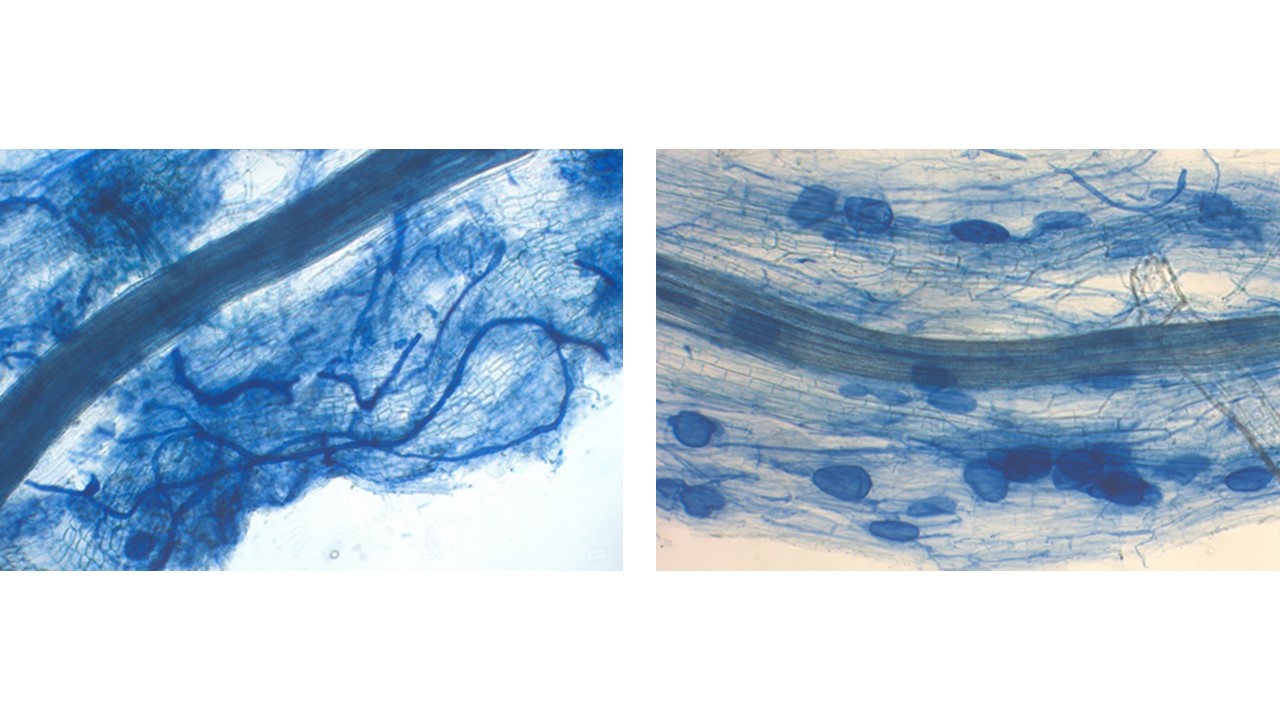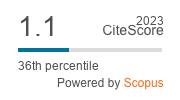Natural mycorrhizal colonization of different apricot rootstocks
DOI:
https://doi.org/10.55779/nsb16211818Keywords:
colonization, mycorrhizae, Prunus armeniaca, rootstock, symbiosisAbstract
Mycorrhizae provide a permanent, reliable and natural way to reap the benefits of symbiosis. Since the susceptibility of different apricot rootstocks to mycorrhization varies considerably, tree conditions can be improved to varying degrees. To determine the degree of naturally occurring colonization (low, high and total), we tested two Hungarian scion cultivars (‘Gönci magyar kajszi’ and ‘Ceglédi szilárd’) with six rootstock cultivars from different origins. The results were obtained by microscopic analysis of dyed root samples. The rootstocks ‘Apricot seedling’ and ‘Myrobalan 29C’ are the most susceptible in our orchards. The insufficient colonization of the plum rootstocks ‘Wavit’ and ‘Fehér besztercei’ could be due to the water requirements of plum as a rootstock, which puts them at a disadvantage in non-irrigated conditions. However, no statistical differences were found between the rootstocks in the proportion of uncolonized roots, except that the roots of 'Gönci magyar kajszi' were more colonized than those of ‘Ceglédi szilárd’.
Metrics
References
Agromillora Group (2023). Retrieved 2023 January 18 form: https://www.agromillora.com/wp-content/uploads/2020/05/Agromillora_Rootpac_English.pdf
Allen EB, Allen MF (1980) Natural re-establishment of vesicular-arbuscular mycorrhizae following strip mine reclamation in Wyoming. Journal of Applied Ecology 17:139-147. https://doi.org/10.2307/2402969
Augé M (2001). Water relations, drought, and vesicular-arbuscular mycorrhizal symbiosis. Mycorrhiza 11:3-42. https://doi.org/10.1007/s005720100097
Azcón R, Ocampo JA (1981). Factors affecting the vesicular-arbuscular infestation and MD of thirteen wheat cultivars. New Phytologist 87:677-685. https://doi.org/10.1111/j.1469-8137.1981.tb01702.x
Badenes ML, Parfitt DE (1995). Phylogenetic relationships of cultivated Prunus species from an analysis of chloroplast DNA variation. Theoretical and Applied Genetics 90:1035-1041. https://doi.org/10.1007/BF00222918
Bago B, Pfeffer PE, Abubaker J, Jun J, Allen JW, Brouillette J, Douds DD, Lammers PJ, Shachar-Hill Y (2003). Carbon export from arbuscular mycorrhizal roots involves the translocation of carbohydrate as well as lipid. Plant Physiology 131(3):1496-1507. http://dx.doi.org/10.1104/pp.102.007765
Bakos JL, Sheak RB, Erős-Honti Zs, Ladányi M, Szalay L, Biró B (2019). Mikorrhiza kolonizáció különböző fagytűrésű, M9 alanyú alma- és vadalanyú kajszifajtáknál a téli nyugalmi időszak alatt. [Mycorrhizal colonization of different frost-tolerant M9 apple and wild apple cultivars during winter dormancy.] Kertgazdaság 51(4):3-16.
Bassi D, Audergon JM (2006). Apricot breeding: update and perspectives. Acta Horticulturae 701:279-294. https://doi.org/10.17660/ActaHortic.2006.701.43
Beckman TG, Okie WR, Meyers SC (1992). Rootstocks affect bloom date and fruit maturation of ‘Redhaven’ peach. American Journal of Horticultural Science 117(3):377-379. https://doi.org/10.21273/JASHS.117.3.377
Bi Y, Xie L, Wang Z, Wang K, Liu W, Xie W (2021). Arbuscular mycorrhizal symbiosis facilitates apricot seedling (Prunus sibirica L.) growth and photosynthesis in northwest China. International Journal of Coal Science & Technology 8:473-482. https://doi.org/10.1007/s40789-021-00408-6
Boyhan GE, Norton JD, Pitts JA (1995). Establishment, growth, and foliar nutrient content of plum trees on various rootstocks. American Journal of Horticultural Science 30(2):219-221. https://doi.org/10.21273/HORTSCI.30.2.219
Bryla DR, Koide RT (1990). Role of mycorrhizal infection in the growth and reproduction of wild vs. cultivated plants: II. Eight wild accessions and two cultivars of Lycopersicon esculentum Mill. Oecologia 84:82-92. https://doi.org/10.1007/BF00665599
Cruz AF, Soares WRO, Blum LEB (2014). Impact of the arbuscular mycorrhizal fungi and bacteria on biocontrol of white root rot in fruit seedlings. Journal of Plant Physiology and Pathology 2(1):2. https://doi.org/10.4172/2329-955X.1000114
Darikova JA, Savva YV, Eugene A, Vaganov EA, Grachev AM, Kuznetsova GV (2011). Grafts of woody plants and the problem of incompatibility between scion and rootstock (a review). Journal of Siberian Federal University. Biology 4:54-63. http://dx.doi.org/10.17516/1997-1389-0185
Dutt S, Sharma SD, Kumar P (2013a). Arbuscular mycorrhizas and Zn fertilization modify growth and physiological behavior of apricot (Prunus armeniaca L.). Scientia Horticulturae 155:97-104. https://doi.org/10.1016/j.scienta.2013.03.012
Dutt S, Sharma SD, Kumar P (2013b). Inoculation of apricot seedlings with indigenous arbuscular mycorrhizal fungi in optimum phosphorus fertilization for quality growth attributes. Journal of Plant Nutrition 36(1):15-31. https://doi.org/10.1080/01904167.2012.732648
Duval H, Masse M, Jay M, Loquet B (2012). Results of French apricot rootstock trials. Acta Horticulturae 966:37-41. https://doi.org/10.17660/ActaHortic.2012.966.4
FAOSTAT (2023). Retrieved 2023 January 18 from: http://www.fao.org/faostat/
Foschi S, Bassi D, Lama M, Buscaroli C, Rizzo M (2012). Nuovi portinnesti dell’albicocco: meno polloni e buona affinità. [New apricot rootstocks: less suckers and good affinity.] L’informatore Agrario 21:56-59.
Grace C, Stribley DP (1991). A safer procedure for routine staining of vesicular-arbuscular mycorrhizal fungi. Mycological Research 95(10):1160-1162. https://doi.org/10.1016/S0953-7562(09)80005-1
Hrotkó K (1999). Gyümölcsfaiskola. [Fruit tree nursery.) Mezőgazda Kiadó, Budapest.
Irisarri P, Errea P, Pina A (2021). Physiological and molecular characterization of new apricot cultivars grafted on different Prunus rootstocks. Agronomy 11:1464. https://doi.org/10.3390/agronomy11081464
Kaschuk G, Kuyper TW, Leffelaar PA, Hungria M, Giller KE (2009). Are the rates of photosynthesis stimulated by the carbon sink strength of rhizobial and arbuscular mycorrhizal symbioses? Soil Biology and Biochemistry 41:1233-1244. https://doi.org/10.1016/j.soilbio.2009.03.005
Liu J, Maldonado‐Mendoza I, Lopez‐Meyer M, Cheung F, Town CD, Harrison MJ. (2007). Arbuscular mycorrhizal symbiosis is accompanied by local and systemic alterations in gene expression and an increase in disease resistance in the shoots. The Plant Journal 50 (3):529-544. https://doi.org/10.1111/j.1365-313X.2007.03069.x
Mendelné Pászti E, Mendel Á (2021). Vegetative growth of apricot (P. armeniaca L.) cultivars and rootstocks. COLUMELLA–Journal of Agricultural and Environmental Sciences 8(1):5-12. https://doi.org/10.18380/SZIE.COLUM.2021.8.1.5
Mendelné Pászti E, Bujdosó G, Mendel Á (2022). Vegetative characteristics of three apricot cultivars grafted on six different rootstocks. Horticulturae 8(11):1004. https://doi.org/10.3390/horticulturae8111004
Mendelné Pászti E, Bujdoso G, Ercisli S, Hrotkó K, Mendel Á (2023). Apricot rootstocks with potential in Hungary. Horticulturae 9(6):720. https://doi.org/10.3390/horticulturae9060720
Menge JA, Johnson ELV, Platt RG (1978). Mycorrhizal de-pendency of several citrus cultivar under three nutrient regimes. New Phytologist 81:553-560. https://doi.org/10.1111/j.1469-8137.1978.tb01628.x
Missere D, Pirazzini P, Mezzetti B, Capocasa F, Sottile F, Scalas B, Podda A, Pirazzini P, Sottile F, Pennone F, Carbone A, Scarpato L (2010). New low-vigour apricot rootstocks compared. Acta Horticulturae 862:295-300. https://doi.org/10.17660/ActaHortic.2010.862.45
Mohammad MJ, Hamad SR, Malkawi HI (2003). Population of arbuscular mycorrhizal fungi in semi-arid environment of Jordan as influenced by biotic and abiotic factors. Journal of Arid Environments 53(3):409-417. https://doi.org/10.1006/jare.2002.1046
Moustafa K, Cross J (2019). Production, pomological and nutraceutical properties of apricot. Journal of Food Science and Technology 56(1):12-23. https://doi.org/10.1007/s13197-018-3481-7
Mowrey BD, Werner DJ (1990). Phylogenetic relationships among species of Prunus as inferred by isozyme markers. Theoretical and Applied Genetics 80(1):129-33. https://doi.org/10.1007/BF00224026
Nagy P, Lantos A (1996). Breeding stone fruit rootstocks in Hungary. Acta Horticulturae 622:531-551. https://doi.org/10.17660/ActaHortic.1998.484.33
Parniske M (2008). Arbuscular mycorrhiza: the mother of plant root endosymbioses. Nature Reviews Microbiology 6:763-775. https://doi.org/10.1038/nrmicro1987
Pászti E, Mendel Á (2018). Életképességi vizsgálatok összehasonlítása csonthéjas alanyok magvain. [Comparison of viability studies on seeds of stone fruit rootstocks.] Kertgazdaság 50(3):15-21.
Phillips JM, Hayman DS (1970). Improved procedures for clearing roots and staining parasitic and vesicular arbuscular mycorrhizal fungi for rapid assessment of infection. Transactions of the British Mycological Society 55(1):158-161. https://doi.org/10.1016/S0007-1536(70)80110-3
Pinochet J (2010). ‘Replantpac’ (Rootpac R), a plum–almond hybrid rootstock for replant situations. American Journal of Horticultural Science 45(2):299-301. https://doi.org/10.21273/HORTSCI.45.2.299
Przybyłko S, Kowalczyk W, Wrona D (2021). The effect of mycorrhizal fungi and PGPR on tree nutritional status and growth in organic apple production. Agronomy 11(7):1402. https://doi.org/10.3390/agronomy11071402
Püschel DJ, Rydlová J, Vosátka M (2008). Does the sequence of plant dominants affect mycorrhiza development in simulated succession on spoil banks? Plant Soil 302:273-282. https://doi.org/10.1007/s11104-007-9480-5
Santoyo G, Gamalero E, Glick BR (2021). Mycorrhizal-bacterial amelioration of plant abiotic and biotic stress. Frontiers in Sustainable Food Systems 5:672881. https://doi.org/10.3389/fsufs.2021.672881
Schussler A, Schwarzott D, Walker C (2001). A new fungal phylum, the Glomeromycota: phylogeny and evolution. Mycologycal Research 105:1413-1421. https://doi.org/10.1017/S0953756201005196
Sitarek M, Bartosiewicz B (2011). Influence of few seedling rootstocks on the growth, yield and fruit quality of apricot trees. Journal of Fruit Ornamental Plant Research 19(2):81-86.
Smith SE, Facelli E, Pope S, Smith FA (2010). Plant performance in stressful environments: interpreting new and established knowledge of the roles of arbuscular mycorrhizas. Plant Soil 326:3-20. https://doi.org/10.1007/s11104-009-9981-5
Surányi D (1999). Wild apricot and myrobalan (generative) rootstocks for apricot cultivars. Acta Horticulturae 488:445-449. https://doi.org/0.17660/ActaHortic.1999.488.71
Szücs E, Véghelyi K (1996). Observation with Entoloma clypeatum mycorrhizal fungus in Hungarian orchards. In IV International Symposium on Replant Problems, 477:123-126. https://doi.org/10.17660/ActaHortic.1998.477.15
Taaren MJ, Abbasi AN, Rahman H (2016). Tree vigor, nutrients uptake efficiency and yield of ‘Floridaking’ peach cultivar as affected by different rootstocks. Proceedings of Pakistan Society for Horticultural Sciences 134-143.
Tawaraya K, Imai T, Wagatsuma T (1999). Importance of root length in mycorrhizal colonisation of Welsh onion. Journal of Plant Nutrition 22:589-596. https://doi.org/10.1080/01904169909365654
Tawaraya K (2003). Arbuscular mycorrhizal dependency of different plant species and cultivars. Soil Science and Plant Nutrition 49(5):655-668. https://doi.org/10.1080/00380768.2003.10410323
Vavilov NI (1926). The mountainous districts as the home of agriculture. Studies on the origin of cultivated plants. Bulletin of Applied Botany 16:218-220. http://dx.doi.org/10.3366/anh.1994.21.1.142a
Vavilov NI (1951). Phytogeographic basis of plant breeding. Chronica Botanica 13-54. https://doi.org/10.12691/ajfn-5-1-1
Yordanov AI, Tabakov SG, Kaymakanov PV (2015). Comparative study of WAVIT® rootstock with two plum and two apricot cultivars in nursery. Journal of Agricultural Sciences 60(2):159-168. https://doi.org/10.2298/JAS1502159Y

Downloads
Published
How to Cite
Issue
Section
License
Copyright (c) 2024 József László BAKOS, László SZALAY, Edina MENDELNÉ PÁSZTI, Ákos MENDEL

This work is licensed under a Creative Commons Attribution 4.0 International License.
Papers published in Notulae Scientia Biologicae are Open-Access, distributed under the terms and conditions of the Creative Commons Attribution License.
© Articles by the authors; licensee SMTCT, Cluj-Napoca, Romania. The journal allows the author(s) to hold the copyright/to retain publishing rights without restriction.
License:
Open Access Journal - the journal offers free, immediate, and unrestricted access to peer-reviewed research and scholarly work, due SMTCT supports to increase the visibility, accessibility and reputation of the researchers, regardless of geography and their budgets. Users are allowed to read, download, copy, distribute, print, search, or link to the full texts of the articles, or use them for any other lawful purpose, without asking prior permission from the publisher or the author.













.png)















